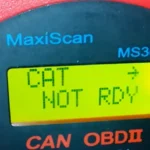An illuminating check engine light (CEL) on your car dash is an indication that the vehicle isn’t in perfect condition. Because of its location and function, the catalytic converter is seldom suspected as a potential reason the CEL stays on.
I understand that sluggish engine performance, dark exhaust smoke, excessive heat or reduced acceleration are symptomatic of weak cats. But do you know that a failing cat (to use its short form) can cause your vehicle’s check engine light to come on? How? Read this article to the end to know why the cats might be responsible for this issue.
What to Know About an Illuminating Check Engine Light
Let me start by saying there’s danger in driving a car with an illuminating check engine light. As a warning light, the check engine light can illuminate and remain steady or come on and keep blinking. Depending on the car, the color of the CEL can be orange, yellow, or amber.
Whether steady or blinking, a check engine light could indicate multiple electrical or mechanical faults in your car. A rapidly blinking CEL indicates a more severe engine problem. Conversely, a steady and constantly illuminated CEL signals that the car is suffering some unresolved internal issues. The latter scenario doesn’t indicate an emergency.
In either case, you cannot easily decipher what’s wrong with the car. You need a diagnosis to ascertain the exact issue. Some signs you might notice alongside the illuminated check engine light are listed below. The symptoms depend on what causes the warning light to come on.
- Loss of engine performance and power
- Increased fuel consumption
- Cold stalling
- Rough idle
- Engine misfire
- Short fuel mileage
- Dark pub
- Engine overheating
How Catalytic Converter Causes Check Engine to Illuminate
The catalytic converter is a metal box in a car’s exhaust system to help filter out harmful carbon deposits. It essentially breaks down the gaseous substance coming out of the car’s tailpipe. After cleaning up the emissions, the cats burn up these harmful exhaust gases. However, the cat through the oxidation process turns any unburned hydrocarbons into water and CO2
A damaged catalytic converter is a severe threat to your car. Don’t forget, the cats perform beyond merely filtering out harmful substances in the exhaust gases. They also burn these byproducts up to prevent damage to the engine. The case becomes worse if your car uses leaded fuel because it prevents the cat from disintegrating the exhaust-bound pollution.
A blinking CEL could also indicate an engine misfire. A severe engine misfire can be due to several reasons. When fuel leaves the combustion chamber unburned, it dumps in the exhaust system. Consequently, the unburned fuel lights off as soon as it gets to the catalytic converter, damaging it along the line.
So, if you drive your car with a bad cat, these dangerous substances keep building up. First, a partial engine failure will trigger the check engine light to come on. The longer the cats remain faulty and unfixed, the higher the chance of complete engine failure.
As the check engine light flashes, the engine will start to experience a misfire resulting from a severely damaged catalytic converter. In the process, the cat will get overheated and might potentially cause a fire hazard.
So, you don’t want to take any chances with your engine. Take your car to your mechanic and has the problem and its symptoms resolve. The thing is that the cat doesn’t start to fail unless some other problems have occurred.
A faulty ignition coil is my number issue. Once the ignition coil suffers high temperature beneath the hood, it might go bad. Once this happens, the catalytic converter becomes the victim. Spark plugs, like the ignition coil, get their power from the car battery. Any damage to the spark plugs will trigger damage to the cat.
How to avoid a Damaged Catalytic Converter
The only remedy for a damaged catalytic converter is to replace it. But again, it depends on what’s responsible for the cat’s failure. The best cure is prevention. Here are steps to avoid damage to your car cats.
Ensure engine tune-up
You’ll need to tune up your car engine regularly. Try to stick to the proper air-fuel mixture. Replacing all worn and damaged components is also critical. Make sure your engine is operating within proper specs to prevent the cat from failing.
Avoid excess fuel in the exhaust
Excess unburned fuel that gets into the exhaust system from the combustion chamber will overheat the converter. Regular and scheduled maintenance will check this potential threat and prevent cat damage.
Never Ride on Bad Road
As much as possible, try to avoid bad terrain. The cat works with a thin-walled catalyst. The material is made from a lightweight ceramic coated with a dense insulator. The catalytic converter could crack or break when road rock strikes or hits it hard.
Replace bad oxygen sensor
It’s a no-brainer that incorrect readings of gases from the exhaust system can cause a too-rich or too-lean fuel mixture. When it’s too rich, engine parts like the cat-bound catalyst can damage. Replace the air sensor to avoid further engine damage.
FAQs
Can a bad catalytic converter cause the check engine light to flash?
Absolutely, when the cat develops any fault, the check engine light may start to flash. The reason could be that your engine is overheated. A flashing light on the dash indicates that you need to resolve the problem as quickly as possible. This isn’t the right to drive a long distance or at a fast speed. You should take your vehicle to an expert to run a scan.
What are other reasons my check engine light will come on?
So far, I’ve explained how a defective catalytic converter can be a culprit when your check engine light illuminates. Here are other potential causes of illuminating or flashing CEL:
- Loose gas/fuel cap
- Malfunctioning oxygen sensor
- Damaged exhaust gas recirculation (EGR) valve
- Leaky vacuum holes
- BadMass Air Flow Sensor
Remember, I mentioned bad ignition and failing spark plugs earlier.
Final Thoughts
As I often advise, you shouldn’t explain the cause of your vehicle’s problem based on hearsay or guesswork. Until you run a scan on it, don’t assume why a car behaves this or that way. Imagine someone had told you before now that a bad cat can make the check engine light come on. In all, ensure a diagnosis is carried out before applying any fix.



